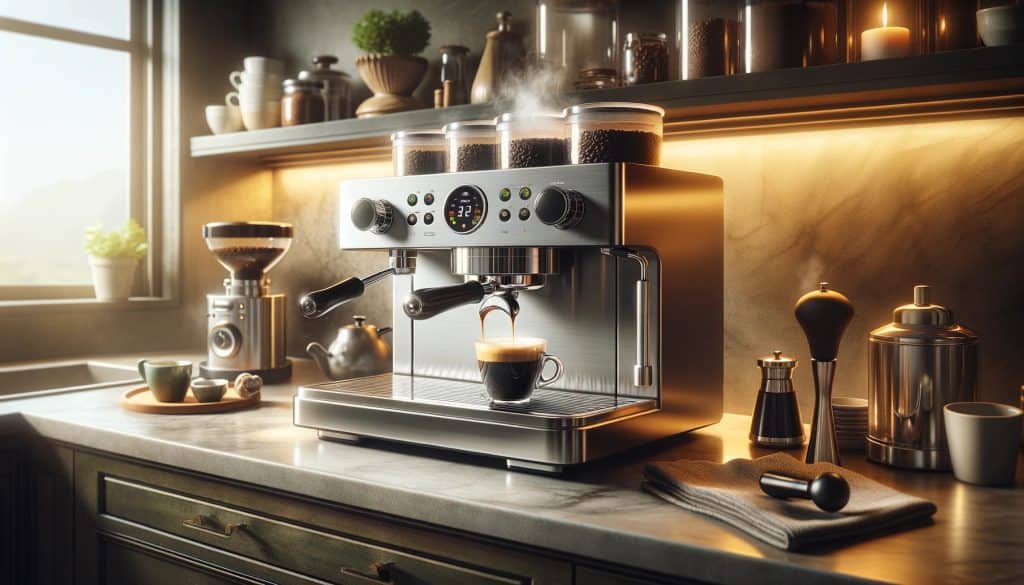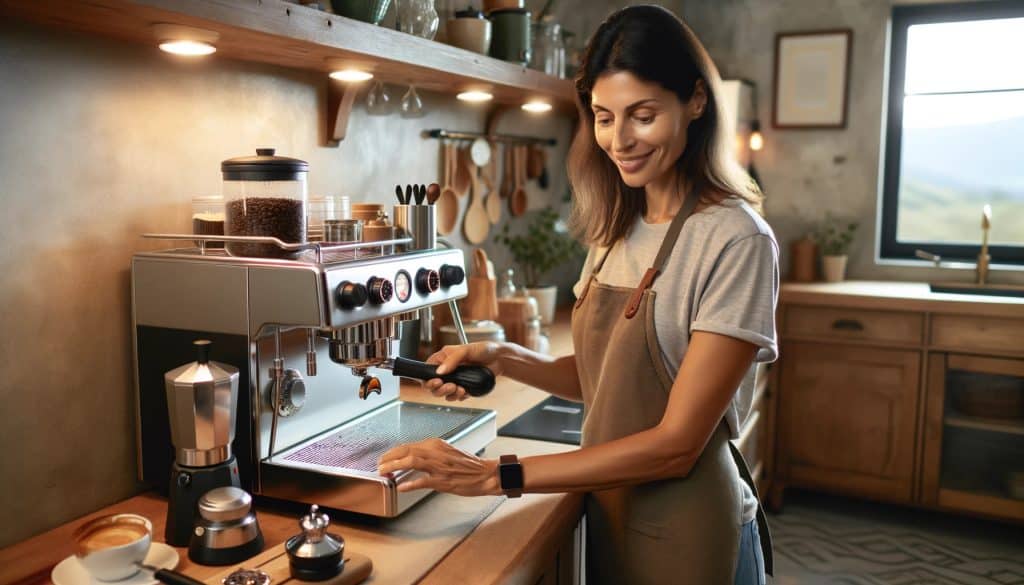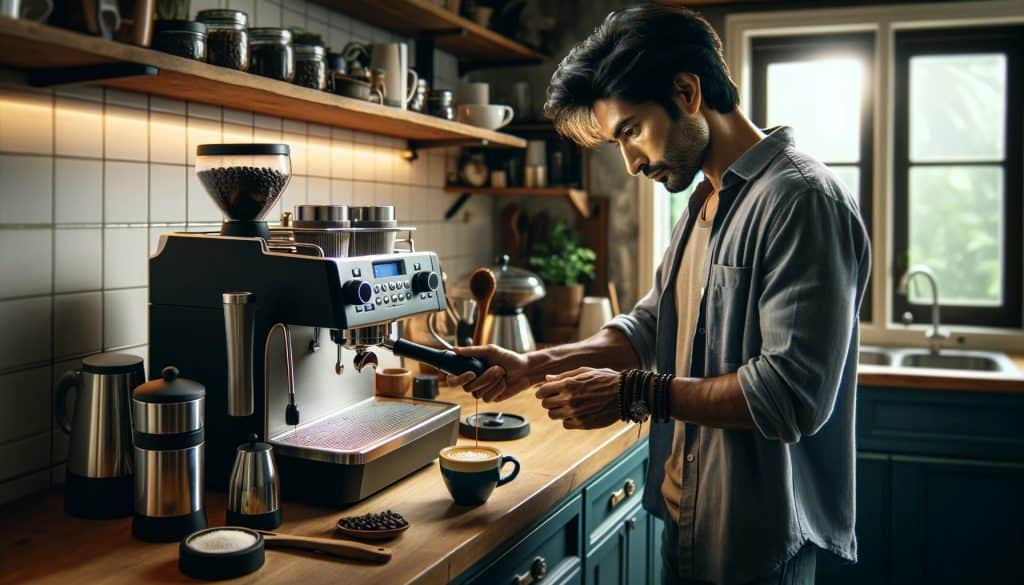The quest for the perfect espresso is akin to a meticulous dance of pressure and temperature. It’s not just about having the right ingredients or the fanciest machine; it’s about understanding and mastering these two critical variables. The magic in a cup of espresso unfolds t ough this delicate balance.
The Perfect Espresso: More Than Just Coffee
The perfect espresso is a symphony of rich aroma, robust flavor, and inviting crema. This tiny, powerful shot is the cornerstone of coffee culture. But what truly sets it apart? The answer lies in its extraction process, a process governed by precise pressure and temperature.
Pressure: The Unsung Hero
In the world of espresso, pressure is the unsung hero. It’s what transforms hot water and fine coffee grounds into the elixir we love. Most machines operate at around 9 bars of pressure, the equivalent of nine times the atmospheric pressure at sea level. This intense pressure is necessary to extract the coffee’s oils, flavors, and aromas, creating that rich and creamy consistency.
Temperature: The Delicate Balance
While pressure does the heavy lifting, temperature fine-tunes the flavor. The ideal brewing temperature for espresso is between 195°F and 205°F. Any hotter, and you risk burning the coffee, creating a bitter taste. Too cool, and the extraction is underwhelming, leading to a flat, under-extracted shot.
The Interplay Between Pressure and Temperature
Understanding the interplay between pressure and temperature is crucial. Here’s a simple breakdown:
- Pressure: Essential for extraction, creating crema, and unlocking flavor.
- Temperature: Ensures the right flavor profile and aroma are achieved.
Achieving the perfect espresso is a journey of understanding and manipulating pressure and temperature. It’s not just about the end product; it’s about appreciating the science and art behind each cup. So, the next time you sip on your espresso, remember the delicate dance that made it possible.
< class="wp-block-separator has-alpha-channel-opacity"/>The Basics of Espresso Making
Espresso is not just a coffee drink; it’s a cultural icon, an art form, and for many, a daily ritual. Understanding its essence, history, and the machinery behind it adds depth to our appreciation of this beloved beverage.

Definition of Espresso
Espresso is a concentrated coffee beverage brewed by forcing hot water under high pressure t ough finely-ground coffee. It’s distinguished by its full flavor, rich aroma, and a layer of creamy foam called crema. Espresso forms the base for various popular coffee drinks, like lattes and cappuccinos.
A Brief History of Espresso Machines
The journey of espresso machines began in the early 20th century. The first espresso machines were large, bulky, and steam-driven. It wasn’t until the mid-1900s that the machines evolved into the sleek, efficient models we see today, thanks to advancements in technology and design. This evolution made espresso more accessible and popular worldwide.
The Heart of the Espresso Machine: Its Main Components
At the heart of espresso-making are the machine’s main components:
- Group Head: This is where the magic begins. The group head is the part of the machine where hot water from the boiler is dispensed t ough the coffee grounds.
- Portafilter: A handle with a basket at the end, the portafilter holds the coffee grounds. It locks into the group head to brew the espresso.
- Boiler: The boiler heats the water to the right temperature. It’s crucial for both brewing the coffee and, in many machines, generating steam for frothing milk.
Understanding the basics of espresso and its machinery enhances our appreciation of each cup. Whether you’re a casual drinker or a coffee enthusiast, knowing the what, why, and how of espresso adds depth to every sip.
< class="wp-block-separator has-alpha-channel-opacity"/>The Role of Pressure in Espresso Extraction
When it comes to brewing the perfect espresso, pressure isn’t just a detail – it’s the cornerstone. Understanding the role of pressure in espresso extraction is key to appreciating and crafting top-notch espresso.

Understanding Extraction Pressure
Extraction pressure refers to the force used to push water t ough the coffee grounds. In espresso making, this pressure is what extracts the flavors and oils from the coffee. Typically, this pressure is around 9 bars (or 9 times the atmospheric pressure at sea level). It’s this high pressure that distinguishes espresso from other brewing methods.
The Impact of Pressure on Espresso Quality
- Crema Formation: The crema, a creamy, golden-brown foam, is a hallmark of a well-extracted espresso. The pressure helps emulsify oils and sugars in coffee, creating this layer. A good crema is a sign of fresh coffee and proper extraction.
- Extraction Rate: Pressure also influences how quickly the flavors are extracted from the coffee grounds. The right pressure ensures a balance between extracting desirable flavors and avoiding over-extraction, which can lead to bitterness.
The Optimal Pressure Range for Espresso Machines
Most experts agree that the sweet spot for espresso extraction is around 8-9 bars of pressure. This range is ideal for achieving the best balance of flavor extraction without over-extracting. Higher-end espresso machines allow baristas to control and experiment with this pressure to fine-tune the flavor profile.
The role of pressure in espresso extraction is both an art and a science. It’s what makes espresso uniquely intense and flavorful. Understanding and mastering this aspect can elevate your espresso experience, whether you’re a home brewer or a professional barista.
< class="wp-block-separator has-alpha-channel-opacity"/>Temperature’s Impact on Espresso Quality

Importance of Brewing Temperature
- Brewing temperature is crucial in espresso making. It determines the extraction of flavors and compounds from the coffee grounds.
- Too high temperatures can lead to over-extraction, causing bitterness. Too low, and the espresso may be under-extracted, leading to a sour taste.
- Achieving the right temperature balances the espresso’s acidity, bitterness, and overall flavor profile.
How Temperature Variations Affect Espresso Taste
- Acidity: Lower temperatures tend to enhance acidity, giving a brighter flavor to the espresso.
- Bitterness: Higher temperatures can increase bitterness, which may overpower the subtle flavors of the coffee.
- Aroma: The right brewing temperature ensures the release of aromatic compounds, enhancing the sensory experience of the espresso.
- Temperature consistency is key. Fluctuations can lead to inconsistent shots and a compromised taste.
Ideal Temperature Range for Brewing Espresso
- The optimal temperature range for brewing espresso is typically between 195°F and 205°F (90.5°C – 96.1°C).
- Precision in maintaining this range is important for consistency in flavor and quality.
- Many high-end espresso machines offer temperature control settings to aid in achieving this precision.
Understanding and controlling the brewing temperature is essential in making a perfect cup of espresso. It influences the balance of flavors and the overall quality of the drink.
< class="wp-block-separator has-alpha-channel-opacity"/>The Interplay Between Pressure and Temperature

How Pressure and Temperature Work Together in Espresso Extraction
- In espresso making, pressure and temperature are not just two separate elements; they are interdependent factors that work together to extract the best flavors from coffee.
- The pressure pushes hot water t ough the coffee grounds, while the temperature determines the rate and efficiency of flavor extraction.
- The right balance of pressure and temperature ensures a full-bodied espresso with rich flavor and proper crema.
Case Studies or Examples of Pressure and Temperature Balance
- Example of High Pressure and High Temperature: When both are set too high, the espresso can become overly bitter and burnt. This often results in a harsh taste, losing the subtle flavors of the coffee.
- Example of Low Pressure and Low Temperature: On the flip side, low pressure and temperature can lead to under-extraction, resulting in a weak, sour espresso lacking depth.
- Balanced Case Study: The ideal scenario is a medium to high pressure (around 9 bars) combined with a temperature in the range of 195°F to 205°F. This balance is often used in specialty coffee shops and results in a rich, flavorful, and aromatic espresso.
- Experimentation in Specialty Coffee: Some baristas experiment with slightly varying pressure and temperature to highlight different flavor profiles in single-origin coffees or blends.
Understanding the complex relationship between pressure and temperature is key to mastering espresso extraction. Each element influences the other, and together they determine the final quality of the espresso shot.
< class="wp-block-separator has-alpha-channel-opacity"/>Tips for Home Baristas
Making great espresso at home is an art. It’s about understanding and controlling two key factors: pressure and temperature. Mastering these can turn you from a coffee enthusiast into a skilled home barista.

1. Understanding Pressure and Temperature
Most espresso machines come with pressure and temperature settings. Here’s why they’re important:
- Pressure: The pressure in an espresso machine pushes hot water t ough the coffee grounds. This extracts the coffee’s flavors and oils. The standard pressure is about 9 bars. Getting this right is crucial for that perfect espresso shot.
- Temperature: The brewing temperature impacts the taste of your espresso. Too hot, and your coffee might taste burnt. Too cold, and it could be under-extracted, resulting in a weak flavor. The ideal temperature range is between 195°F and 205°F.
2. Monitoring and Adjusting Settings
- Pressure Gauges: Check if your machine has a pressure gauge. This helps you monitor the pressure during extraction.
- Temperature Control: Some machines have built-in thermometers or PID controllers for precise temperature control.
- Adjusting: Start with the manufacturer’s settings. Then, experiment by slightly adjusting the pressure and temperature to see how it affects the taste.
3. Common Mistakes to Avoid
- Ignoring the Manual: Always start by reading your machine’s manual. It gives you the basic guidelines for pressure and temperature settings.
- Overheating: Don’t let the machine get too hot. This can burn the coffee.
- Inconsistent Grind: Make sure your coffee grind is consistent. Uneven grinds can lead to uneven extraction.
4. Recommended Entry-Level Machines
- Look for machines with pressure and temperature control. This might be a bit more expensive, but it’s worth it for quality espresso.
- Consider the build quality. A sturdy machine lasts longer and performs better.
With a bit of practice and patience, you can make excellent espresso at home. Remember, every coffee bean is different, so feel free to experiment with pressure and temperature. Enjoy the process, and soon you’ll be making barista-level coffee in the comfort of your own kitchen.
< class="wp-block-separator has-alpha-channel-opacity"/>Advanced Techniques for Espresso Enthusiasts

Exploring Pre-infusion and Its Impact on Extraction
- Definition of Pre-infusion: Pre-infusion is a technique used in espresso extraction where a small amount of water is first introduced to the coffee grounds before the full extraction begins. This initial wetting helps to evenly saturate the coffee, leading to a more balanced and nuanced flavor profile.
- Benefits of Pre-infusion:
- Enhances Flavor Extraction: Pre-infusion allows the coffee grounds to expand, facilitating a more uniform extraction of flavors.
- Reduces Channeling: It helps in minimizing channeling, where water passes t ough the coffee unevenly, often resulting in over-extraction in some areas and under-extraction in others.
- Customization: Allows baristas to experiment with different pre-infusion times to achieve specific flavor profiles.
Experimenting with Pressure Profiling
- What is Pressure Profiling?: Pressure profiling is the process of varying the water pressure during the espresso extraction. This technique allows for different flavors to be extracted at different stages of the brewing process.
- Techniques in Pressure Profiling:
- Gradual Increase: Starting with a lower pressure and gradually increasing it can enhance the sweetness and body of the espresso.
- High-to-Low Pressure: Beginning with high pressure and reducing it during extraction can highlight the acidity and clarity of the coffee.
- Equipment for Pressure Profiling: While not all espresso machines are equipped for pressure profiling, many modern machines have this capability. It’s an advanced technique that requires a sophisticated machine with adjustable pressure settings.
Tips for Home Baristas
- Monitoring Pressure and Temperature:
- Invest in a good quality espresso machine with a reliable pressure gauge.
- Use a thermometer to ensure your brewing temperature is consistent.
- Avoiding Common Mistakes:
- Don’t ignore the importance of grind size and tamping pressure.
- Avoid using stale coffee beans, as they greatly affect the flavor and extraction quality.
- Recommendations for Machines:
- Look for machines with PID controllers for stable temperature control.
- Machines with adjustable pressure settings are preferable for those interested in experimenting with pressure profiling.
By understanding and experimenting with advanced techniques like pre-infusion and pressure profiling, home baristas can greatly enhance their espresso-making skills, leading to a more enjoyable and fulfilling coffee experience.


